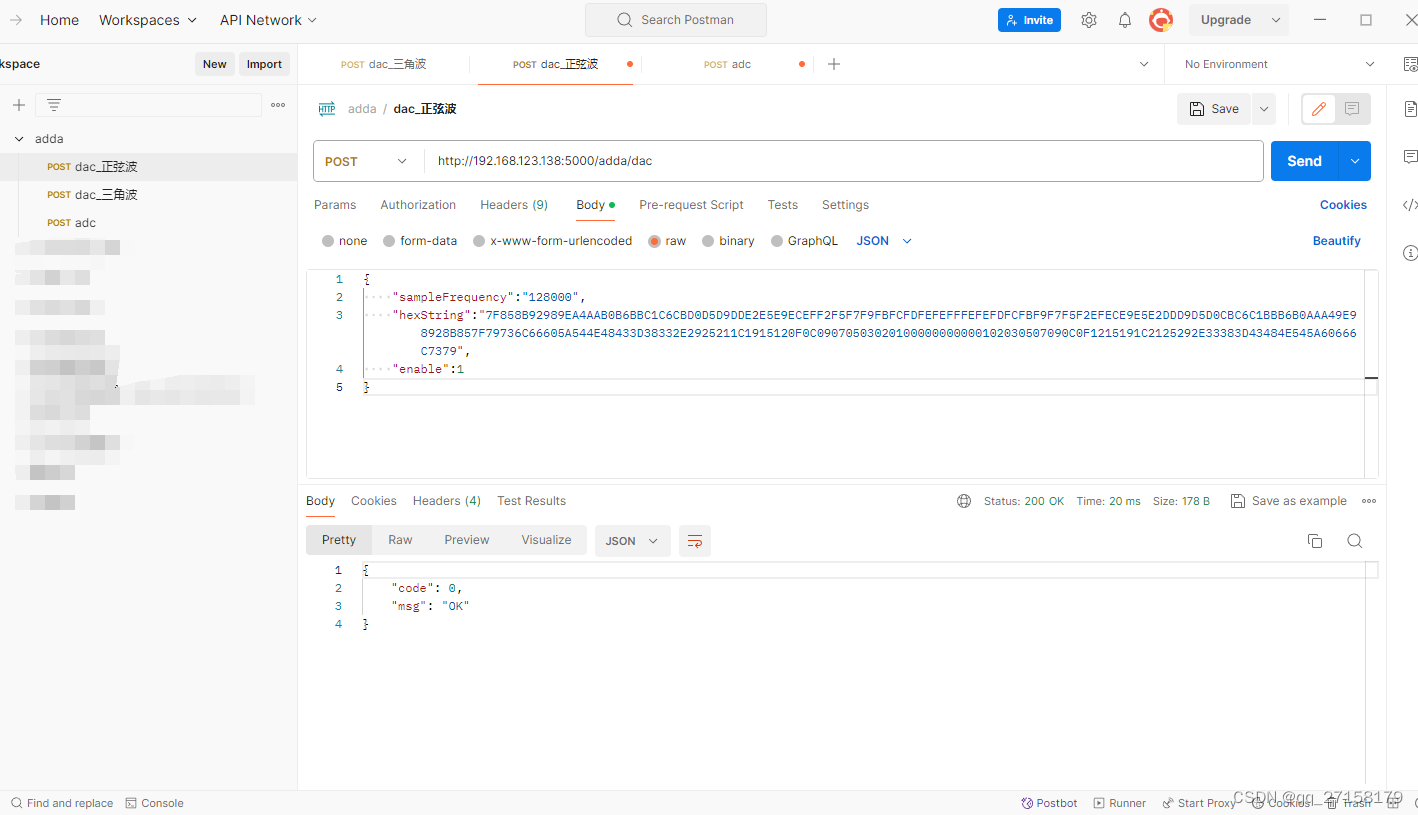petalinux_zynq7 驱动DAC以及ADC模块之四:python实现http_api
前文:
petalinux_zynq7 C语言驱动DAC以及ADC模块之一:建立IP![]() https://blog.csdn.net/qq_27158179/article/details/136234296petalinux_zynq7 C语言驱动DAC以及ADC模块之二:petalinux
https://blog.csdn.net/qq_27158179/article/details/136234296petalinux_zynq7 C语言驱动DAC以及ADC模块之二:petalinux![]() https://blog.csdn.net/qq_27158179/article/details/136236138petalinux_zynq7 C语言驱动DAC以及ADC模块之三:实现C语言API并编译出库被python调用
https://blog.csdn.net/qq_27158179/article/details/136236138petalinux_zynq7 C语言驱动DAC以及ADC模块之三:实现C语言API并编译出库被python调用![]() https://blog.csdn.net/qq_27158179/article/details/136238093本文用python + flask 在zynq中给出http api。用postman测试。
https://blog.csdn.net/qq_27158179/article/details/136238093本文用python + flask 在zynq中给出http api。用postman测试。
1. adda_api.py
from flask import Flask, jsonify, request
from adda_service import adda_service
# Flask初始化参数尽量使用你的包名,这个初始化方式是官方推荐的,官方解释:http://flask.pocoo.org/docs/0.12/api/#flask.Flask
app = Flask(__name__)
app.config['JSON_AS_ASCII'] = False # 禁止中文转义
@app.route("/adda/dac", methods=["POST"])
def adda_dac():
httpInstance = adda_service()
ret = httpInstance.adda_dac()
return ret
@app.route("/adda/adc", methods=["POST"])
def adda_adc():
httpInstance = adda_service()
ret = httpInstance.adda_adc()
return ret
@app.route('/HelloWorld')
def hello_world():
return "Hello World!"
if __name__ == "__main__":
app.run(host="0.0.0.0")
2. adda_lib.py
import ctypes
import time
ll = ctypes.cdll.LoadLibrary
libadda = ll("./libadda.so")
class adda_lib():
def __init__(self):
pass
# 输出十六进制类型数组
def print_hex(self, bytes):
l = [hex(int(i)) for i in bytes]
print(" ".join(l))
# 字节列表以16进制格式打印数据
def bytes_to_hexstring(self, data):
lin = ['%02X' % i for i in data]# [ ]内是列表解析语法 ,'%02X'%是格式化语法。
hex_str = " ".join(lin)
return hex_str
# init
def adda_open(self):
libadda.adda_open.restype = ctypes.c_int
ret = libadda.adda_open()
# close
def adda_close(self):
libadda.adda_close.restype = ctypes.c_int
ret = libadda.adda_close()
# dac 采样频率
def adda_DacSetSampleFrequency(self, value):
libadda.adda_DacSetSampleFrequency.argtype = ctypes.c_int
libadda.adda_DacSetSampleFrequency.restype = ctypes.c_int
sample_frequency = ctypes.c_uint(value)
ret = libadda.adda_DacSetSampleFrequency(sample_frequency)
# dac 数组 - 正弦波
def adda_DacGenDataSin(self, desire_length):
# uint8_t dac_buf[1024]
libadda.adda_DacGenDataSin.argtype = [ctypes.POINTER(ctypes.c_ubyte*1024), ctypes.c_int]
libadda.adda_DacGenDataSin.restype = ctypes.c_int
dac_buf = ctypes.create_string_buffer(desire_length)
dac_length = ctypes.c_uint(desire_length)
ret = libadda.adda_DacGenDataSin(dac_buf, dac_length)
ba_raw = bytearray(dac_buf.raw)
ba_out = bytearray(dac_length.value)
for i in range(dac_length.value):
ba_out[i] = ba_raw[i]
# print("ba_out", ba_out)
b_out = bytes(ba_out)
return b_out
# dac 数组 - 三角波
def adda_DacGenDataTriangle(self, desire_length):
# uint8_t dac_buf[1024]
libadda.adda_DacGenDataTriangle.argtype = [ctypes.POINTER(ctypes.c_ubyte*1024), ctypes.c_int]
libadda.adda_DacGenDataTriangle.restype = ctypes.c_int
dac_buf = ctypes.create_string_buffer(desire_length)
dac_length = ctypes.c_uint(desire_length)
ret = libadda.adda_DacGenDataTriangle(dac_buf, dac_length)
ba_raw = bytearray(dac_buf.raw)
ba_out = bytearray(dac_length.value)
for i in range(dac_length.value):
ba_out[i] = ba_raw[i]
# print("ba_out", ba_out)
b_out = bytes(ba_out)
return b_out
# dac 数组 - 设置
def adda_DacSetData(self, data_bytes):
libadda.adda_DacSetData.argtype = [ctypes.POINTER(ctypes.c_ubyte*1024), ctypes.c_int]
libadda.adda_DacSetData.restype = ctypes.c_int
dac_buf = ctypes.create_string_buffer(data_bytes)
dac_length = ctypes.c_uint(len(data_bytes))
ret = libadda.adda_DacSetData(dac_buf, dac_length)
# dac 设置输出
def adda_DacSetOutput(self, enable):
libadda.adda_DacSetOutput.argtype = ctypes.c_int
libadda.adda_DacSetOutput.restype = ctypes.c_int
value = ctypes.c_int(enable)
ret = libadda.adda_DacSetOutput(value)
# dac demo 1
def demo_dac_sin(self):
#libadda.demo_dac_sin()
# init
self.adda_open()
self.adda_DacSetSampleFrequency(128000)
# dac 数组 - 正弦波
dac_length = 128
dac_buf = self.adda_DacGenDataSin(dac_length)
print("dac_buf: ", self.bytes_to_hexstring(dac_buf))
self.adda_DacSetData(dac_buf)
# dac输出开启
self.adda_DacSetOutput(1)
# close
self.adda_close()
# dac demo 2
def demo_dac_triangle(self):
# libadda.demo_dac_triangle()
# init
self.adda_open()
self.adda_DacSetSampleFrequency(128000)
# dac 数组 - 三角波
dac_length = 128
dac_buf = self.adda_DacGenDataTriangle(dac_length)
print("dac_buf: ", self.bytes_to_hexstring(dac_buf))
self.adda_DacSetData(dac_buf)
# dac输出开启
self.adda_DacSetOutput(1)
# close
self.adda_close()
# adc 采样频率
def adda_AdcSetSampleFrequency(self, value):
libadda.adda_AdcSetSampleFrequency.argtype = ctypes.c_int
libadda.adda_AdcSetSampleFrequency.restype = ctypes.c_int
sample_frequency = ctypes.c_uint(value)
ret = libadda.adda_AdcSetSampleFrequency(sample_frequency)
# adc 获取采样数据
def adda_AdcSampleData(self, desire_length):
libadda.adda_AdcSampleData.argtype = [ctypes.POINTER(ctypes.c_ubyte*1024), ctypes.c_int]
libadda.adda_AdcSampleData.restype = ctypes.c_int
adc_buf = ctypes.create_string_buffer(desire_length)
adc_length = ctypes.c_uint(desire_length)
ret = libadda.adda_AdcSampleData(adc_buf, adc_length)
ba_raw = bytearray(adc_buf.raw)
ba_out = bytearray(adc_length.value)
for i in range(adc_length.value):
ba_out[i] = ba_raw[i]
# print("ba_out", ba_out)
b_out = bytes(ba_out)
return b_out
# adc demo
def demo_adc(self):
# init
self.adda_open()
# 设置采样频率
self.adda_AdcSetSampleFrequency(100000)
# 开始采样
adc_length = 300
adc_buff = self.adda_AdcSampleData(adc_length)
# close
self.adda_close()
# 打印结果
print("adc_buff: ", self.bytes_to_hexstring(adc_buff))
3. adda_service.py
from flask import Flask, jsonify, request
from adda_lib import adda_lib
class adda_service():
def __init__(self):
pass
def adda_dac(self):
"""
设置DAC
:return:
"""
data = request.get_json()
sampleFrequency = int(data.get("sampleFrequency"))
hexString = data.get("hexString")
enable = int(data.get("enable"))
addaLibInst = adda_lib()
# ret = addaLibInst.demo_dac_sin()
# ret = addaLibInst.demo_dac_triangle()
ret = addaLibInst.adda_open()
ret = addaLibInst.adda_DacSetSampleFrequency(sampleFrequency)
ret = addaLibInst.adda_DacSetData(bytes.fromhex(hexString))
ret = addaLibInst.adda_DacSetOutput(enable)
ret = addaLibInst.adda_close()
return jsonify({
"code": 0,
"msg": "OK"
})
def adda_adc(self):
"""
ADC读取
:return:
"""
data = request.get_json()
sampleFrequency = int(data.get("sampleFrequency"))
adc_length = int(data.get("adc_length"))
addaLibInst = adda_lib()
ret = addaLibInst.adda_open()
ret = addaLibInst.adda_AdcSetSampleFrequency(sampleFrequency)
adc_buff = addaLibInst.adda_AdcSampleData(adc_length)
adc_result = addaLibInst.bytes_to_hexstring(adc_buff)
# print("adc_result: ", adc_result)
ret = addaLibInst.adda_close()
return jsonify({
"code": 0,
"msg": "OK",
"hexString":adc_result
})
4. 运行
4.1 拷贝文件
把adda_api.py,adda_lib.py,adda_service,libadda.so,拷贝到zynq的linux系统内。
4.2 准备网络
把zynq板卡和电脑连接同一个路由器。
4.3 zynq运行 adda_api.py

5. postman调试http接口
5.1 测试dac输出正弦波
http方法:post,http://192.168.123.138:5000/adda/dac
Body,raw:
{
"sampleFrequency":"128000",
"hexString":"7F858B92989EA4AAB0B6BBC1C6CBD0D5D9DDE2E5E9ECEFF2F5F7F9FBFCFDFEFEFFFEFEFDFCFBF9F7F5F2EFECE9E5E2DDD9D5D0CBC6C1BBB6B0AAA49E98928B857F79736C66605A544E48433D38332E2925211C1915120F0C09070503020100000000000102030507090C0F1215191C2125292E33383D43484E545A60666C7379",
"enable":1
}

5.2 测试dac输出三角波
{
"sampleFrequency":"128000",
"hexString":"0001030507090B0D0F11131517191B1D1F21232527292B2D2F31333537393B3D3F41434547494B4D4F51535557595B5D5F61636567696B6D6F71737577797B7D7F81838587898B8D8F91939597999B9D9FA1A3A5A7A9ABADAFB1B3B5B7B9BBBDBFC1C3C5C7C9CBCDCFD1D3D5D7D9DBDDDFE1E3E5E7E9EBEDEFF1F3F5F7F9FBFD",
"enable":1
}


5.3 测试adc
post,http://192.168.123.138:5000/adda/adc
Body,raw:
{
"sampleFrequency":"100000",
"adc_length":100
}

下篇:
原文地址:https://blog.csdn.net/qq_27158179/article/details/136239572
免责声明:本站文章内容转载自网络资源,如本站内容侵犯了原著者的合法权益,可联系本站删除。更多内容请关注自学内容网(zxcms.com)!
